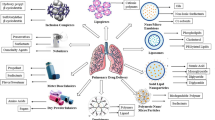Abstract
There are potential therapeutic advantages in administering drugs as sustained release formulations to the lungs. This presents the challenges of controlling drug release from particles within the lung environment while overcoming the natural clearance mechanisms. Approaches being adopted involve the administration of particles of small aerodynamic diameter to the alveoli and avoiding phagocytosis by high phospholipid content or large geometric particle size. Studies in animals have demonstrated the utility of such formulations.
Similar content being viewed by others
References
Smith PL. Peptide delivery via the pulmonary route: a valid approach for local and systemic delivery. J Control Release 1997; 46: 99–106.
Heinemann L, Traut T, Heise T. Time-action profile of inhaled insulin. Diabetic Med 1997; 14: 63–72.
Patton JS, Bukar J, Nagrajan S. Inhaled insulin. Adv Drug Deliv Rev 1999; 35: 235–47.
Barnes PJ. Asthma therapy with aerosols: clinical relevance for the next decade. J Aerosol Med 1996; 9: 131–41.
Ben-Jebria A, Chen D, Eskew ML, et al. Large porous particles for sustained protection from carbachol-induced bronchocon-striction in guinea pigs. Pharm Res 1999; 16: 555–61.
Barnes PJ, Adcock IM. Transcription factors and asthma. Eur Respir J 1998; 12:221–34.
Pavia D, Thomson ML, Clarke SW, et al. Effect of lung function and mode of inhalation on penetration of aerosol into the human lung. Thorax 1977; 32: 194–7.
Kreyling WG, Blanchard JD, Godleski JJ, et al. Anatomic localization of 24- and 96-h particle retention in canine airways. J Appl Physiol 1999; 87: 269–84.
Brain JD. Macrophages in the respiratory tract. In: Fishman AP, Fisher AB, editors. Handbook of physiology: the respiratory system 1. Bethesda (MD): American Physiological Society, 1985: 447–71.
Patton JS. Mechanisms of macromolecule absorption by the lungs. Adv Drug Del Rev 1996; 19: 3–36.
Bowden DH. Macrophages, dust, and pulmonary diseases. Expl Lung Res 1987; 12:89–107.
Newman SP, Agnew JE, Pavia D, et al. Inhaled aerosols: lung deposition and clinical applications. Clin Phys Physiol Meas 1982; 3: 1–20.
Edwards DA, Ben-Jebria A, Langer R. Recent advances in pulmonary drug delivery using large, porous inhaled particles. J Appl Physiol 1998 Aug; 85 (2): 379–85.
Vanbever R, Mintzes JD, Wang J, et al. Formulation and physical characterization of large porous particles for inhalation. Pharm Res 1999; 16: 1735–42.
Nicholas TE. Pulmonary surfactant: no mere paint on the alveolar wall. Respirology 1996; 1: 247–57.
Evora C, Soriano I, Rogers RA, et al. Relating the phagocytosis of microparticles by alveolar macrophages to surface chemistry: the effect of 1,2-dipalmitoylphosphatidylcholine. J Control Release 1998; 51: 143–52.
Hardy JG. Drug delivery to the respiratory tract. In: Perkins AC, Frier M, editors. Nuclear medicine in pharmaceutical research. London: Taylor & Francis, 1999: 41–56.
Dolovich M. New propellant-free technologies under investigation. J Aerosol Med 1999; 12 Suppl. 1: S9–17.
Costantino HR, Carrasquillo KG, Cordero RA, et al. Effect of excipients on the stability and structure of lyophilized recombinant human growth hormone. J Pharm Sci 1998; 87: 1412–20.
Taylor LS, Williams AC, York P. Particle size dependent molecular rearrangements during the dehydration of trehalose dihy-drate: in situ FT-Raman spectroscopy. Pharm Res 1998; 15: 1207–14.
Taylor LS, Zografi G. Sugar-polymer hydrogen bond interactions in lyophilized amorphous mixtures. J Pharm Sci 1998; 87: 1615–21.
Crotts G, Park TG. Protein delivery from poly(lactic-co-glycolic acid) biodegradable microspheres: release kinetics and stability issues. J Microencapsulation 1998; 15: 699–713.
Talton J, Fitz-Gerald J, Singh R, et al. Nano-thin coastings for improved lung targeting of glucocorticoid dry powders: in vitro and in vivo characteristics. In: Dalby RN, Byron PR, Farr SJ, et al., editors. Proceedings of Respiratory Drug Delivery VII; 2000 May 14–18; Tarpon Springs (FL). Raleigh (NC): Serentec Press, 2000; 1: 67–74.
Suarez S, Gonzalez-Rothi RJ, Schreier H, et al. Effect of dose and release rate on pulmonary targeting of liposomal triamcinolone acetonide phosphate. Pharm Res 1998; 15: 461–5.
Mobley WC. The effect of jet-milling on lyophilized liposomes. Pharm Res 1998; 15: 149–52.
Edwards DA, Hanes J, Caponetti G, et al. Large porous particles for pulmonary drug delivery. Science 1997; 276: 1868–71.
Wang J, Ben-Jebria A, Edwards DA. Inhalation of estradiol for sustained systemic delivery. J Aerosol Med 1999; 12: 27–36.
Dellamary LA, Tarara TE, Smith DJ, et al. Hollow porous particles in metered dose inhalers. Pharm Res 2000; 17: 168–74.
Wolff RK, Allen DL, Hughes BL, et al. The case for route-dependent toxicology comparisons: using large animal models to speed clinical development of inhaled proteins. In: Dalby RN, Byron PR, Farr SJ, et al., editors. Proceedings of Respiratory Drug Delivery VII; 2000 May 14–18; Tarpon Springs (FL). Raleigh (NC): Serentec Press, 2000; 1: 163–70.
Author information
Authors and Affiliations
Corresponding author
Rights and permissions
About this article
Cite this article
Hardy, J.G., Chadwick, T.S. Sustained Release Drug Delivery to the Lungs. Clin Pharmacokinet 39, 1–4 (2000). https://doi.org/10.2165/00003088-200039010-00001
Published:
Issue Date:
DOI: https://doi.org/10.2165/00003088-200039010-00001




